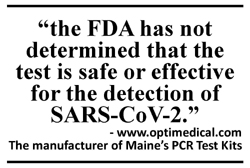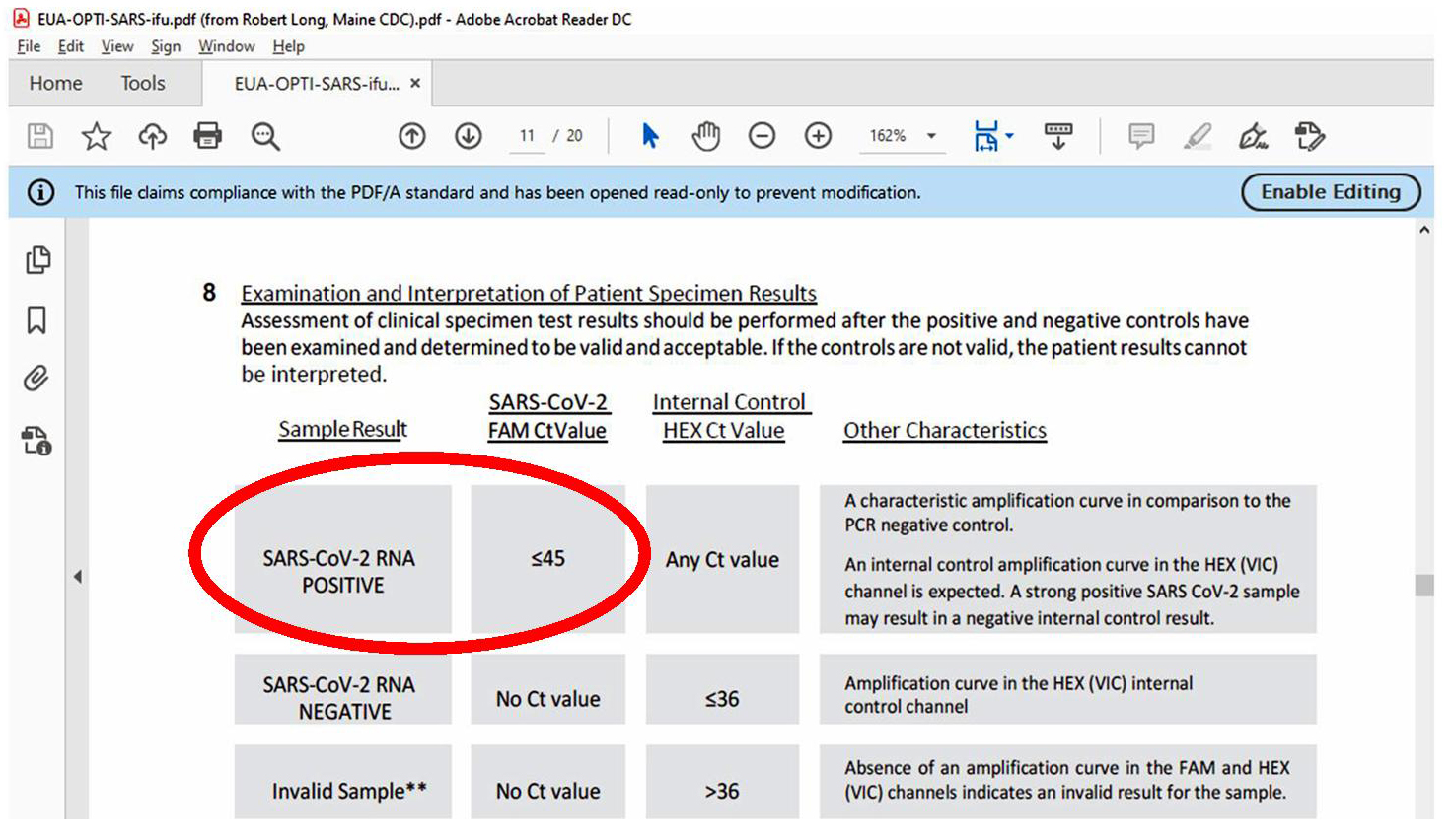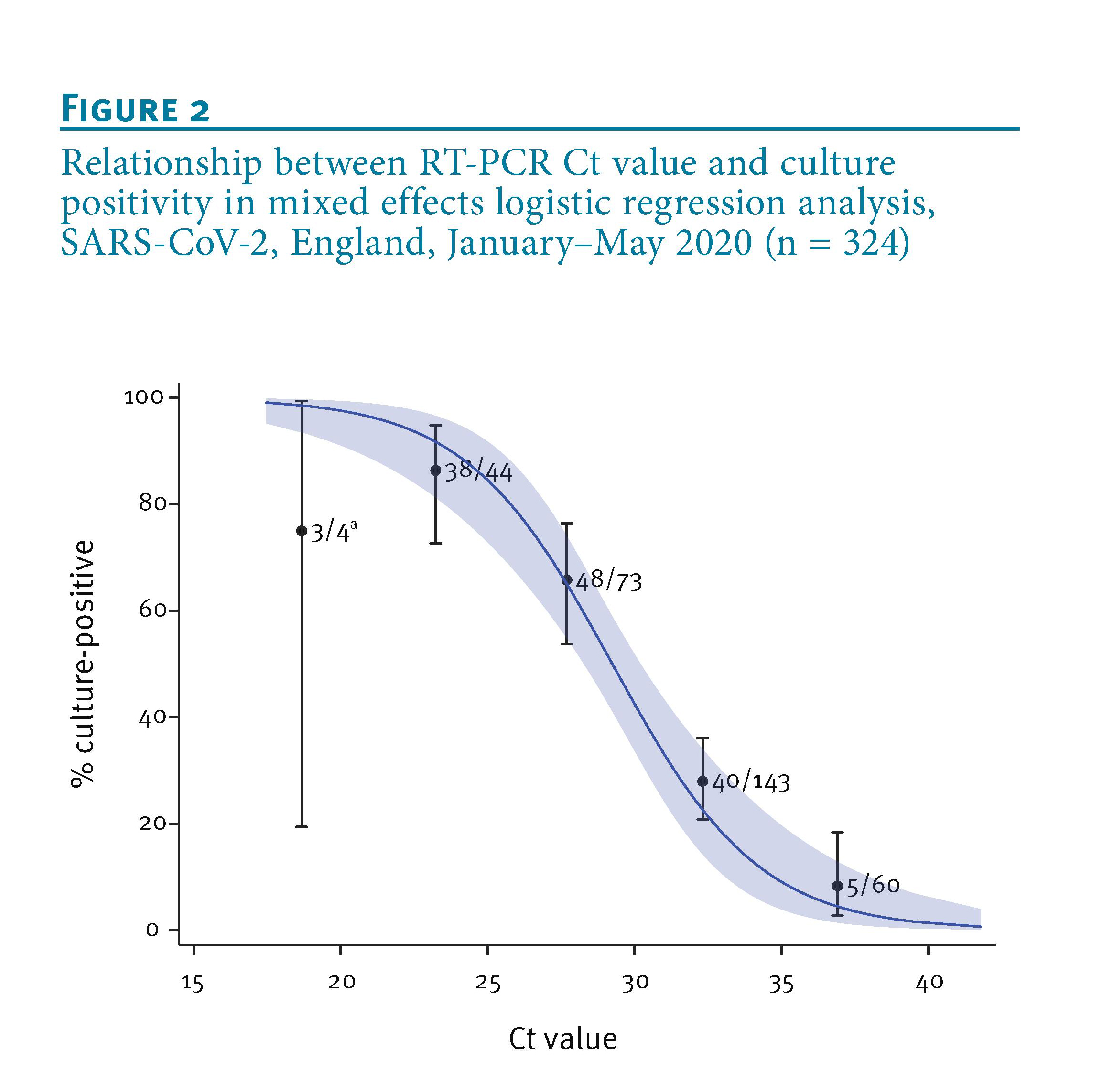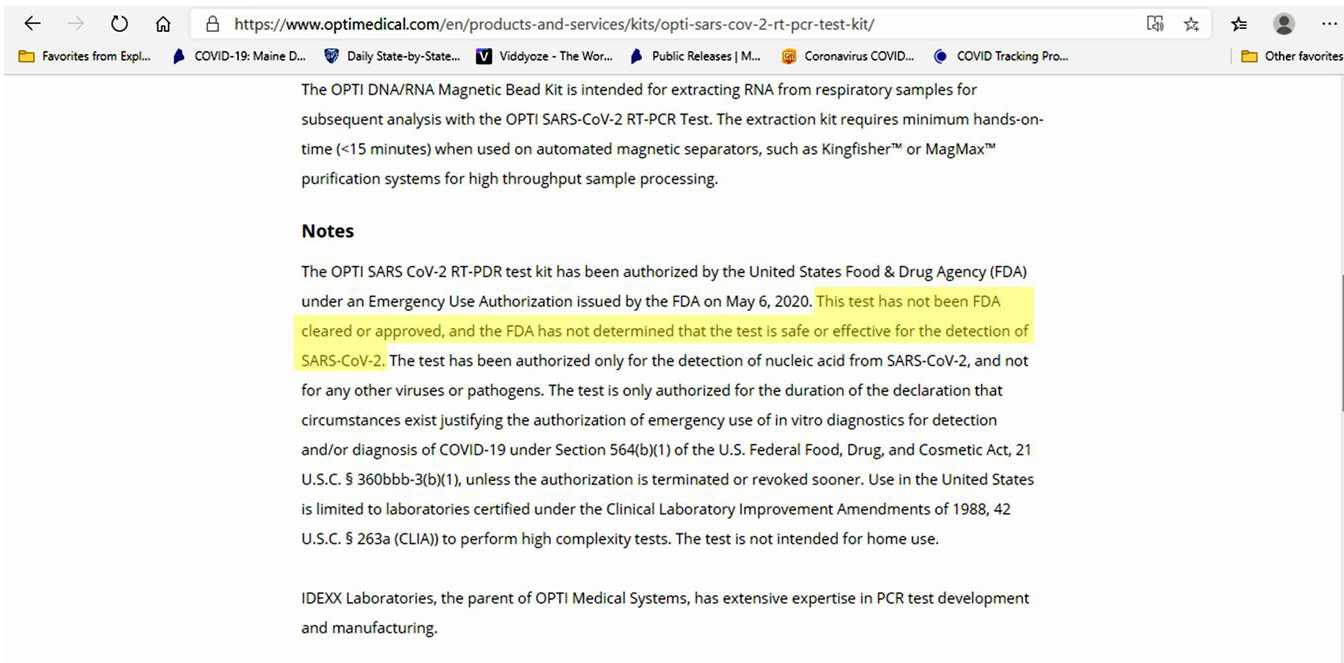Back to Fort Fairfield Journal WFFJ-TV Contact Us
Subscribe to the WFFJ-TV YouTube Channel
Maine’s COVID-19 RT-PCR Tests Are Calibrated too High
Excessive Cycle Threshold of 45 Triggers Maine’s
PCR tests Positive on non-Infectious Viral Fragments
Watch the video here Story text is below
By: David Deschesne
Fort Fairfield Journal, December 2, 2020
The COVID-19 positive case expansion in Maine is due in large part to the massively increased testing over the past sixty days. But, another variable that needs to be considered is the PCR tests Maine is currently using are exceedingly sensitive and thus can key positive on mere fragments of leftover viral RNA that is no longer infectious, or making the person sick, but hasn’t been completely flushed from the body’s respiratory tract.
days. But, another variable that needs to be considered is the PCR tests Maine is currently using are exceedingly sensitive and thus can key positive on mere fragments of leftover viral RNA that is no longer infectious, or making the person sick, but hasn’t been completely flushed from the body’s respiratory tract.
PCR tests do not look for the whole virus. Instead, they use chemicals to amplify levels of its RNA so it might be detected. This amplification, called a “cycle,” is a manufacturing process that successively doubles the amount of viral RNA with every new cycle. The test keeps cycling and amplifying the fragments until a point where they can be detected by the test instruments. The more virus in a sample - the less the test will need to cycle to show a positive result. The normal cycle threshold for someone who is actually sick with a large viral load would be as low as 15 or 20. A sample from someone who has had the virus, but is recovering, may have to be cycled out to 30 or 35 times in order to detect the viral fragments. Positive results derived from Cycle Thresholds of 40 or above are considered non-infectious, featuring mere leftover viral fragments and while the PCR test may indicate “Positive” at this cycle threshold the person will not have enough active, viable virus to get sick, or be infectious.
Most virologists agree that any test that has to cycle over 35 times should be considered “Negative” for the purposes of classifying someone as sick or infectious. Maine is using a PCR test kit that cycles out to a an excessively high Cycle Threshold of 45, which means many of the so-called “positive” COVID-19 cases in the State could be classified as negative.
On Monday, May 18, 2020, The Maine Department of Health & Human Services’ Maine Health Alert Network (HAN) issued a press release stating that the: “Maine CDC has expanded its capacity for COVID-19 testing. This expansion results largely from a partnership with IDEXX (Westbrook, Maine) to use the OPTI SARS-CoV-2 RNA PCR Test Kit...”1
 The test kit is manufactured by OPTI Medical and features an instruction manual that indicates the test goes out to a Cycle Threshold (Ct) of 45.2
The test kit is manufactured by OPTI Medical and features an instruction manual that indicates the test goes out to a Cycle Threshold (Ct) of 45.2
OPTIMedical received US FDA Emergency Use Authorization (EUA) to produce the test. What this means is the accuracy of the test hasn’t been cleared or approved by the FDA. According to OptiMedical’s website, “the FDA has not determined that the test is safe or effective for the detection of SARS-CoV-2.”3 A CDC document entitled, “CDC 2019-Novel Coronavirus (2019-nCoV) Real-Time RT-PCR Diagnostic Panel”, effective July 13, 2020, states that if a “laboratory modifies this test by using unauthorized, alternate components...the modified test is not authorized under the EUA” The CDC document further states for the above modifications, “As part of this policy, FDA does not intend to object when a laboratory modifies an EUA-authorized test, which could include using unauthorized components, without obtaining an EUA or EUA amendment…”
A Rapid Communication from www.eurosuveillance.org dated August 3, 2020 stated that “RT-PCR [tests] do not distinguish between infectious and non-infectious virus.” They further provided a chart (see below) that shows the likelihood of sickness or infectiousness of a COVID-19 patient based upon the Cycle Threshold required to get a positive PCR test result.4
 The chart - and its analysis by the report authors - shows that test results gained from a Cycle Threshold (Ct) of 15 to 20 cycles represent the highest viral load and thus those patients would quite likely be symptomatic and infectious. Tests that require a Ct of 35 have dramatically reduced amount of viral load and those people by-in-large have recovered from COVID-19 and are no longer infectious. Cycle Thresholds over 40 are from stray, non-active viral fragments that are not able to make a person sick, or infectious.
The chart - and its analysis by the report authors - shows that test results gained from a Cycle Threshold (Ct) of 15 to 20 cycles represent the highest viral load and thus those patients would quite likely be symptomatic and infectious. Tests that require a Ct of 35 have dramatically reduced amount of viral load and those people by-in-large have recovered from COVID-19 and are no longer infectious. Cycle Thresholds over 40 are from stray, non-active viral fragments that are not able to make a person sick, or infectious.
On August 29, 2020, the New York Times published an article entitled, “Your Coronavirus Test is Positive. Maybe it Shouldn’t Be.”5
In that article they looked at the states of Massachusetts, New York and Nevada and found up to 90 percent of the positive PCR tests in those states cycled out to 40. This means those people carried barely any virus at all and should have been classified as a “Negative” test result. According to a NYT interview with Dr. Michael Mina, an epidemiologist at the Harvard T.H. Chan School of Public Health, “Tests with thresholds so high may detect not just live virus but also genetic fragments, leftovers from infection that pose no particular risk - akin to finding a hair in a room long after a person has left.”
An Editorial Commentary published in the journal, Clinical Infectious Diseases by Michael Tom and Michael Mina stated, “Following complete resolution of symptoms, people can have prolonged positive SARS-CoV-2 RT-PCR test results, potentially for weeks. At these late time points the Ct value is often very high, representing very low copies of viral RNA...A positive RT-qPCR result may not necessarily mean the person is still infectious or that he or she has any meaningful disease.”6
Maine’s PCR tests cycle out to 45 cycles. At this Ct, a PCR test should in all actuality be considered “Negative.”
Nick Murray, writing in The Maine Wire attempted in September to obtain actual Cycle Thresholds for positive PCR tests in Maine from the Maine CDC - he even submitted a Freedom of Information Act (FOIA) request - but is being stonewalled with one pathetic excuse after another.7
“If data from Maine mirrors that from Massachusetts and New York, it would be a bombshell finding,” wrote Murray. “It could render much of the contact-tracing and case-chasing regime that Governor Mills, Dr. Shah and public health officials employ to maintain control over Maine people useless, because the ‘cases’ being tracked are carrying very low amounts of the virus and would be less likely to spread it throughout day-to-day life.”
Of the more than 3,700 new positive cases of COVID-19 in Maine for November, there were only an additional 80 people hospitalized for it.
Notes:
1. https://www.maine.gov/dhhs/mecdc/health-advisory.shtml?id=2546459
2. https://drive.google.com/file/d/1Q_BT9cfylVxNnfpvD8X0gqS6PRS9Y4Z8/view?usp=sharing
3. https://www.optimedical.com/en/products-and-services/kits/opt-sars-cov-2-rt-pcr-test-kit/
4. https://www.ncbi.nlm.nih.gov/pmc/articles/PMC7427302/
5. https://www.nytimes.com/2020/08/29/health/coronavirus-testing.html
6. https://academic.oup.com/cid/article/71/16/2252/5841456
7. https://www.themainewire.com/2020/09/maine-cdc-stalling-release-of-coronavirus-testing-data/



